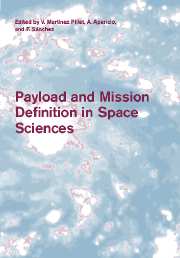Book contents
- Frontmatter
- Contents
- Preface
- Acknowledgements
- 1 The life cycle of an ESA science mission and how to get involved
- 2 Design issues for space science missions
- 3 Instrumentation in X-ray Astronomy
- 4 EUV and UV imaging and spectroscopy from space
- 5 The luminosity oscillations imager, a space instrument: from design to science
- 6 Hipparcos and Gaia: the development of space astrometry in Europe
- 7 Space Physics Instrumentation and Missions
- 8 Planetary observations and landers
Preface
Published online by Cambridge University Press: 19 October 2009
- Frontmatter
- Contents
- Preface
- Acknowledgements
- 1 The life cycle of an ESA science mission and how to get involved
- 2 Design issues for space science missions
- 3 Instrumentation in X-ray Astronomy
- 4 EUV and UV imaging and spectroscopy from space
- 5 The luminosity oscillations imager, a space instrument: from design to science
- 6 Hipparcos and Gaia: the development of space astrometry in Europe
- 7 Space Physics Instrumentation and Missions
- 8 Planetary observations and landers
Summary
The steps needed to define a successful space science mission are numerous. The science drivers, the unique advantages this mission provides over past missions or earth-based experiments, and the payload that it includes are the key factors to guarantee its success. Finding the required information on such topics is not so straightforward, especially as they are usually outside the scope of undergraduate courses. The 2003 Canary Islands Winter School of Astrophysics aimed at providing a focused framework that helps fill this need. Space agencies follow a necessarily complex path towards the selection of a specific mission, as required by the enormous costs that are associated with space activities. The steps towards its completion are elaborate and require careful assessment at every stage. The orbit that will be used and the requirements that are imposed have impacts on the science and the mission budget. Thus, knowing how to make the best use of propulsion technologies and gravity helps from solar system bodies plays a crucial role. The first two chapters of this book cover all these topics and illustrate the complexity of defining space missions as well as how and where look for help (i.e. other than the rarely receptive funding agencies).
The instruments on-board will in the end make the science that has driven the mission. How the science questions translate into specific requirements, and then, into the actual instruments are crucial aspects in the definition of the payload.
- Type
- Chapter
- Information
- Payload and Mission Definition in Space Sciences , pp. vii - viiiPublisher: Cambridge University PressPrint publication year: 2005

